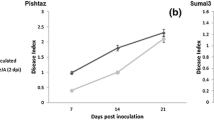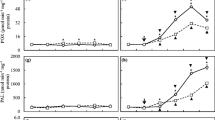Abstract
The induced resistance of potato tuber (Solanum tuberosum cv. Xindaping) tissue against Fusarium sulphureum by a fungal elicitor from the incompatible pathogen Trichothecium roseum and its possible mechanism were studied. The results showed that the lesion development of the wound-inoculated potato tuber was significantly reduced by treatment with the fungal elicitor from T. roseum (P < 0.05). Inoculation with F. sulphureum on the 16th day after treatment with the fungal elicitor80 at 15.0 μg/ml had the best resistant effect in the potato tuber, with the diameter being only reduced by 47 % that of the control. In addition, the results also showed that the potato tuber treated with the fungal elicitor80 could systemically induce lignin deposition, total phenolic content, flavonoid content and defense enzymes, including three keys phenylpropanoid pathway (PAL, 4CL and C4H) and pathogenesis-related (GLU and CHT) enzymes. The fungal elicitor80 also enhanced the up-regulation of the transcription and expression of PAL, C4H, 4CL, GLU and CHT genes. The treatment with the fungal elicitor80 + F. sulphureum caused the marked and/or prompt enhancement of all indexes when compared to treatment with the fungal elicitor80 or inoculation with the pathogen alone. The results suggested that the fungal elicitor of T. roseum could significantly enhance defense responses in potato tuber against dry rot mainly due to the up-regulation of the transcription and expression of resistance-related genes as well as increasing the activity of resistance-related enzymes and antifungal compounds.






Similar content being viewed by others
References
Abeles FB, Forrence LE (1979) Temporal and hormonal control of β-1, 3-glucanase in Phaseolus vulgaris L. Plant Physiol 45:395–400
Adam AL, Pike S, Hoyos ME, Stone JM, Walker JC, Novacky AR (1997) Rapid and transient activation of a myelin basic protein kinase in tobacco leaves treated with harpin from Erwinia amylovora. Plant Physiol 115:853–861
Allen RL, Bittner-Eddy PD, Grenville-Briggs LJ, Meitz JC, Rehmany AP, Rose LE, Beynon JL (2004) Host-parasite coevolutionary conflict between Arabidopsis and downy mildew. Science 306:1957–1960
Apel K, Hirt H (2004) Reactive oxygen species: metabolism, oxidative stress, and signal transduction. Annu Rev Plant Biol 55:373–399
Bao G, Bi Y, Li Y, Kou ZH, Hu LG, Ge YH, Wang Y (2014) Overproduction of reactive oxygen species involved in the pathogenicity of Fusarium in potato tubers. Physiol Mol Plant Pathol 86:35–42
Bi Y, Tian SP, Liu HX, Zhao J, Cao JK, Li YC, Zhang WY (2003) Effect of temperature on chilling injury, decay and quality of Hami melon during storage. Postharvest Biol Technol 29:229–232
Bi Y, Tian SP, Zhao J, Ge YH (2005) Harpin induces local and systemic resistance against Trichothecium roseum in harvested Hami melons. Postharvest Biol Technol 38:183–187
Boller T, Gehri A, Mauch F, Vögeli U (1983) Chitinase in bean leaves: induction by ethylene, purification, properties, and possible function. Planta 157:22–31
Bradford MM (1976) A rapid and sensitive method for the quantitation of microgram quantities of protein utilizing the principle of protein dye binding. Anal Biochem 72:248–254
Bu B, Qiu D, Zeng H (2014) A fungal protein elicitor PevD1 induces Verticillium wilt resistance in cotton. Plant Cell Rep 33:461–470
Chen M, Zeng H, Qiu D, Guo L, Yang X, Shi H, Zhou T, Zhao J (2012) Purification and characterization of a novel hypersensitive response-inducing elicitor from Magnaporthe oryzae that triggers defense response in rice. PLoS One 7:e37654
De W, Pierre JGM, Mehrabi R, Van D, Burg HA, Stergiopoulos I (2009) Fungal effector proteins: past, present and future. Mol Plant Pathol 10:735–747
Desjardins AE, Christ-Harned EA, McCormick SP, Secor GA (1993) Population structure and genetic analysis of field resistance to thiabendazole in gibberella pulicaris from potato tuber. Phytopathology 83:164–170
Dixon RA, Harrison MJ, Lamb CJ (1994) Early events in the activation of plant defense responses. Annu Rev Phytopathol 32:479–501
Droby S, Wisniewski M, Macarisin D, Wilson C (2009) Twenty years of postharvest biocontrol research: is it time for a new paradigm. Postharvest Biol Technol 52:137–145
Durrant WE, Dong X (2004) Systemic acquired resistance. Annu Rev Phytopathol 42:185–209
Ebel J, Mithöfer A (1998) Early events in the elicitation of plant defence. Planta 206:335–348
Ellis JG, Rafiqi M, Gan P, Chakrabarti A, Dodds PN (2009) Recent progress in discovery and functional analysis of effector proteins of fungal and oomycete plant pathogens. Curr Opin Plant Biol 12:399–405
Foyer CH, Noctor G (2005) Oxidant and antioxidant signaling in plants: a reevaluation of the concept of oxidative stress in a physiological context. Plant Cell Environ 28:1056–1071
Garcia-Brugger A, Lamotte O, Vandelle E, Bourque S, Lecourieux D (2006) Early signaling events induced by elicitors of plant defenses. Mol Plant Microbe Interact 19:711–724
Glazebrook J (2005) Contrasting mechanisms of defense against biotrophic and necrotrophic pathogens. Annu Rev Phytopathol 43:205–227
Hammerschmidt R (2008) Challenge inoculation reveals the benefits of resistance priming. Physiol Mol Plant Pathol 73:59–60
Hammond-Kosack KE, Parker JE (2003) Deciphering plant-pathogen communication: fresh perspectives for molecular resistance breeding. Curr Opin Biotechnol 14:177–193
Huang J, Gu M, Lai Z, Fan B, Shi K, Zhou YH, Yu JQ, Chen Z (2010) Functional analysis of the Arabidopsis PAL gene family in plant growth, development, and response to environmental stress. Plant Physiol 153:1526–1538
Kokkonen M, Ojala L, Parikka P, Jestoi M (2010) Mycotoxin production of selected Fusarium species at different culture conditions. Int J Food Microbiol 143:17–25
Kulye M, Liu H, Zhang YL (2012) Hrip1 a novel protein elicitor from necrotrophic fungus, Alternaria tenuissima, elicits cell death, expression of defence-related genes and systemic acquired resistance in tobacco. Plant Cell Environ 35:2104–2120
Li YC, Bi Y, Ge YH, Sun XJ, Wang Y (2009a) Antifungal activity of sodium silicate on Fusarium sulphureum and its effect on dry rot of potato tubers. J Food Sci 74:213–218
Li YC, Bi Y, Hu J, Zhang CY (2009b) Induced resistance in potato tuber tissue against Fusarium sulphureum infection by hyphal cell wall extract from Trichothecium roseum. Acta Botanica Boreal Occident Sinica 29:0749–0753
Li YC, Yin Y, Bi Y (2012) Effect of riboflavin on postharvest disease of Asia pear and the possible mechanisms involved. Phytoparasitica 40:261–268
Livak KJ, Schmittgen TD (2001) Analysis of relative gene expression data using real-time quantitative PCR and the 2−ΔΔC(T) method. Methods 25:402–408
Mao J, Liu Q, Yang X, Long C, Zhao M, Zeng H, Liu H, Yuan J, Qiu D (2010) Purification and expression of a protein elicitor from Alternaria tenuissima and elicitor-mediated defence responses in tobacco. Ann Appl Biol 156:411–420
Morrison IM (1972) A semi-micro method for the determination of lignin and its use in predicting the digestibility of forage crops. J Sci Food Agric 23:455–463
Nürnberger T (1999) Signal perception in plant pathogen defense. Cell Mol Life Sci 55:167–182
Peng DH, Qiu DW, Ruan LF (2011) Protein elicitor PemG1 from Magnaporthe grisea induces systemic acquired resistance (SAR) in plants. Mol Plant Microbe Interact 24:1239–1246
Pirie A, Mullins MG (1976) Changes in anthocyanin and phenolics content of grapevine leaf and fruit tissues treated with sucrose, nitrate and abscisic acid. Plant Physiol 58:468–472
Qiu D, Mao J, Yang X, Zeng H (2009) Expression of an elicitor encoding gene from Magnaporthe grisea enhances resistance against blast disease in transgenic rice. Plant Cell Rep 28:925–933
Rowland O, Ludwig AA, Merrick CJ, Baillieul F, Tracy FE, Durrant WE, Fritz-Laylin L, Nekrasov V, Sjolander K, Yoshioka H, Jones JD (2005) Functional analysis of Avr9/Cf-9 rapidly elicited genes identifies a protein kinase, ACIK1, that is essential for full Cf-9-dependent disease resistance in tomato. Plant Cell 17:295–310
Schoch GA, Nikov GN, Alworth WL, Werck-Reichhart D (2002) Chemical inactivation of the cinnamate 4-hydroxylase allows for the accumulation of salicylicacid in elicited cells. Plant Physiol 130:1022–1031
Silipo A, Erbs G, Shinya T, Dow JM, Parrilli M, Lanzetta R, Shibuya N, Newman MA, Molinaro A (2010) Glyco-conjugates as elicitors or suppressors of plant innate immunity. Glycobiology 20:406–419
Sun XJ, Li YC, Bi Y, Liu J, Yin Y (2009) The investigation and analysis of postharvest diseases of potato in northwest regions. Chin Potato J 23:364–365
Sundar AR, Velazhahan R, Nagarathinam S, Vidhyasekaran P (2008) Induction of pathogenesis-related proteins in sugarcane leaves and cell-cultures by a glycoprotein elicitor isolated from Colletotrichum falcatum. Biol Plant 52:321–328
Terry LA, Joyce DC (2004) Elicitors of induced disease resistance in postharvest horticultural crops: a brief review. Postharvest Biol Technol 32:1–13
Tian SP, Wan YK, Qin GZ, Xu Y (2006) Induction of defense responses against Alternaria rot by different elicitors in harvested pear fruit. Appl Microbiol Biotechnol 70:729–734
Tian SP, Yao HJ, Deng X, Xu XB, Qin GZ, Chan ZL (2007) Characterization and expression of β-1,3-glucanase genes in jujube fruit induced by the microbial biocontrol agent Cryptococcus laurentii. Phytopathology 97:260–268
Van der Ent S, Van Hulten M, Pozo MJ, Czechowski T, Udvardi MK, Pieterse CMJ, Ton J (2009) Priming of plant innate immunity by rhizobacteria and β-aminobutyric acid: differences and similarities in regulation. New Phytol 183:419–431
Wang B, Yang X, Zeng H, Liu H, Zhou T, Tan B, Yuan J, Guo L, Qiu D (2012) The purification and characterization of a novel hypersensitive-like response-inducing elicitor from Verticilliumdahliae that induces resistance responses in tobacco. Appl Microbiol Biotechnol 93:91–201
Wang XL, Xu F, Wang J, Jin P, Zheng YH (2013) Bacillus cereus AR156 induces resistance against Rhizopus rot through priming of defense responses in peach fruit. Food Chem 136:400–406
Wei ZM, Laby RJ, Zumoff CH, Bauer DW, He SY, Collmer A, Beer SV (1992) Harpin, elicitor of the hypersensitive response produced by the plant pathogen Erwinia amylovora. Science 257:85–88
Wei ZQ, Zhang TY, Du X (2006) The occurrence and control of dry rot of potato tuber. Plant Prot 32:103–105
Xu L, Zhu L, Tu L, Liu L, Yuan D, Jin L, Long L, Zhang X (2011) Lignin metabolism has a central role in the resistance of cotton to the wilt fungus Verticllium dahlia as revealed by RNA-Seadependent transcriptional analysis and histochemistry. J Exp Bot 62:5607–5621
Yin Y, Li YC, Bi Y, Cheng SJ, Li YC, Yuan L (2010) Postharvest treatment with baminobutyric acid induces resistance against dry rot caused by Fusarium sulphureum in potato tuber. Agric Sci China 9:1372–1380
Yu MM, Shen L, Zhang AJ, Sheng JP (2011) Methyl jasmonate-induced defense responses are associated with elevation of 1-aminocyclopropane-1-carboxylate oxidase in Lycopersicon esculentum fruit. J Plant Physiol 168:1820–1827
Yun MS, Chen W, Deng F, Kiyokawa T, Mametsuka K, Yogo Y (2006) An in vitro screening assay to discover novel inhibitors of 4-coumarate: CoA ligase. Pest Manag Sci 62:1065–1071
Zhang W, Yang X, Qiu D, Guo L, Zeng H, Mao J, Gao Q (2011) PeaT1-induced systemic acquired resistance in tobacco follows salicylic acid-dependent pathway. Mol Biol Rep 38:2549–2556
Zhao J, Davis LC, Verpoorte R (2005) Elicitor signal transduction leading to production of plant secondary metabolites. Biotechnol Adv 23:283–333
Zhao MZ, Yang XF, Zhang M, Yuan JJ, Qiu DW (2007) Purification and bioactivities of a protein growth-activator from Aternaria tenuissima. Chin J Biol Control 23:170–173
Acknowledgments
This research was financially supported by Special Fund for Agri-biotechnology of Gansu Provincial Department of Agriculture and Animal Husbandry (GNSW-2011-11), and“Fuxi Distinguished Young Talent Cultivation Project”of Gansu Agricultural University.
Author information
Authors and Affiliations
Corresponding author
Rights and permissions
About this article
Cite this article
Yu, Xy., Bi, Y., Yan, L. et al. Activation of phenylpropanoid pathway and PR of potato tuber against Fusarium sulphureum by fungal elicitor from Trichothecium roseum . World J Microbiol Biotechnol 32, 142 (2016). https://doi.org/10.1007/s11274-016-2108-2
Received:
Accepted:
Published:
DOI: https://doi.org/10.1007/s11274-016-2108-2




